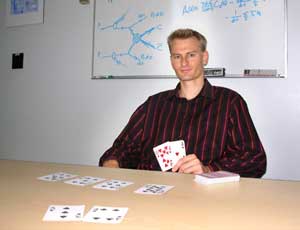Michael Binger

Photo by Krista Zala, SLAC
Not many people would drop $5000 on a celebratory dinner for 25 friends at the Voodoo Lounge in Las Vegas, but that’s just what particle physicist Michael Binger did last August. Binger could well afford the tab: he’d just placed third in the 2006 World Series of Poker, walking away from the tables with a cool $4.1 million. Not bad for a few weeks’ work.
The World Series of Poker is a world-class event, and the No-Limit Texas Hold-Em Championship is the undisputed king of the competition, with more than 8700 people coughing up the requisite $10,000 buy-in in order to do battle over the course of several weeks. Eventually it comes down to nine players at the final table. Binger came into the finals ranked 8th, with just over $3 million in chips. Somehow he parleyed that into his impressive third-place finish against some of the best professional poker players in the world, including Jamie Gold, who won top honors and $12 million.
In reality, Binger’s “overnight success” was the culmination of years of practice–almost as many years as the 29-year-old spent earning his PhD. A love of physics came first. Binger was a hard-core Star Trek fan as a child, and avidly devoured popular science books in high school. He credits his high school physics teacher with encouraging his fledgling interest in the subject, and by graduation, “it was kind of a given” that he’d make physics his chosen career.
As for poker, Binger didn’t get serious about the game until he began his graduate studies in physics at Stanford Linear Accelerator Center (SLAC) under Stanley Brodsky. Binger’s research focused on quantum chromodynamics, supersymmetry, and the Higgs boson.
Binger started playing small-stakes games at local poker rooms in the Bay Area, then moved up to local $200 tournaments. Eventually he amassed a sufficient bankroll to compete in higher-stakes games, although for the 2003 WSOP, he stuck with the $1500 event. He played in the main event for the first time in 2005 and admits he performed horribly.
Binger’s passion for poker detracted a bit from his graduate studies: he did three years of graduate work, took a year off to play poker, then finished up his last three years. He admits that he might have finished sooner, and had a higher rate of publication, if he’d focused more on his research. But there was no quenching the poker fire. Two months after successfully defending his dissertation, he was back at the WSOP main event, and this time the gamble paid off.
There is unquestionably an element of statistics and probability involved in Texas Hold-‘Em, so Binger’s physics training came in handy, particularly when he was just starting out: “It was helpful to know the odds of getting dealt certain hands.” But he cautions against putting too much stock in the numbers, since poker is only partially about the math.
“It’s not solvable by a computer, and there’s not an exactly perfect model,” he told SEED magazine shortly after his WSOP success. “It’s based on an infinite number of variables. It’s not just the odds of having the best hand, drawing the best hand, the size of the pot, or other numerical factors.”
Another key variable is Lady Luck. Every serious poker player has his or her share of “bad beat” stories. That’s what happens when you place a large bet holding the best starting hand, and yet still end up losing on the draw. The worst disappointment is getting “sucked out on the river”: when you’re ahead until the very last card is drawn, almost assured of victory, but your opponent beats the odds to make that gut-shot straight, beating out your three of a kind.
That’s exactly what happened to Binger during the 2006 WSOP competition. He had a day off before heading into the final round, and decided to play a few no-limit ring games in the host casino. He went all-in with a huge advantage over his opponent, and lost on the very last card. The pot size: $18,000. They agreed to run the cards again to see what would happen, and Binger’s opponent once again made the straight on the river. Binger estimates the odds of it happening twice in a row at 70 to 1. Still, he was philosophical about the loss, figuring he’d gotten his bad luck out of the way.
Not that he’s superstitious, mind you: “Your runs of luck will generally not be out of bounds with what the probability statistics say,” he insists. According to Binger, luck only reigns in the short term. Over the long term, the percentages hold sway. He keeps careful records of his own wins and losses, and insists he’s never had a losing year as a poker player. In fact, he has earned the majority of his income since 2002 from poker.
Binger’s strong showing at the WSOP gives him a healthy bankroll to play a few more big tournaments, but he hasn’t given up on physics entirely. He still has an office at SLAC, and eventually hopes to find a balance between physics research and poker. Ideally, he would like to do well enough at amassing poker winnings to conduct his theoretical research without having to scrounge for grant money. Then again, he could write his own book on poker strategy, or perhaps follow in the footsteps of poker champion Phil Gordon by hosting Celebrity Poker Showdown. His future could quite literally be in the cards











